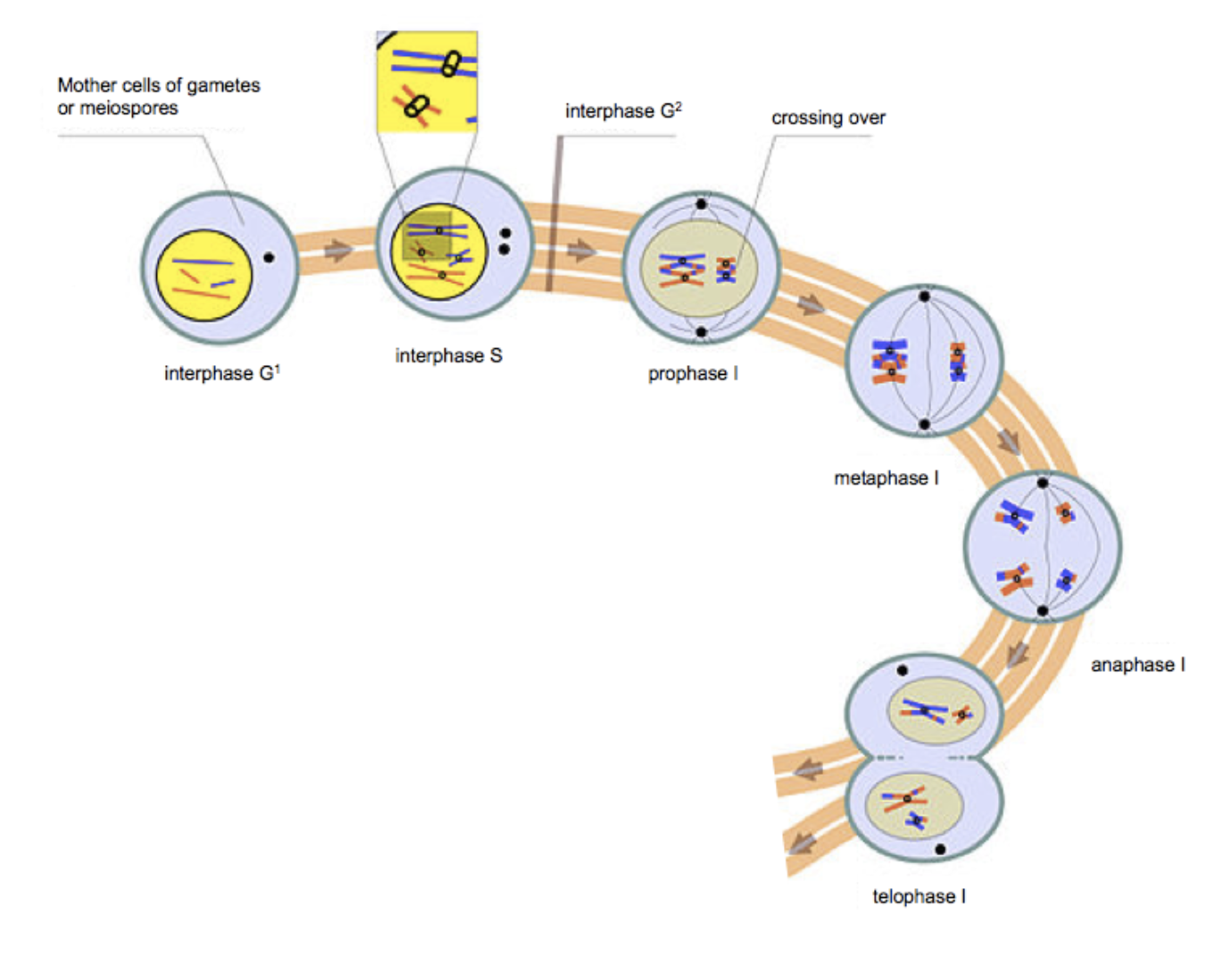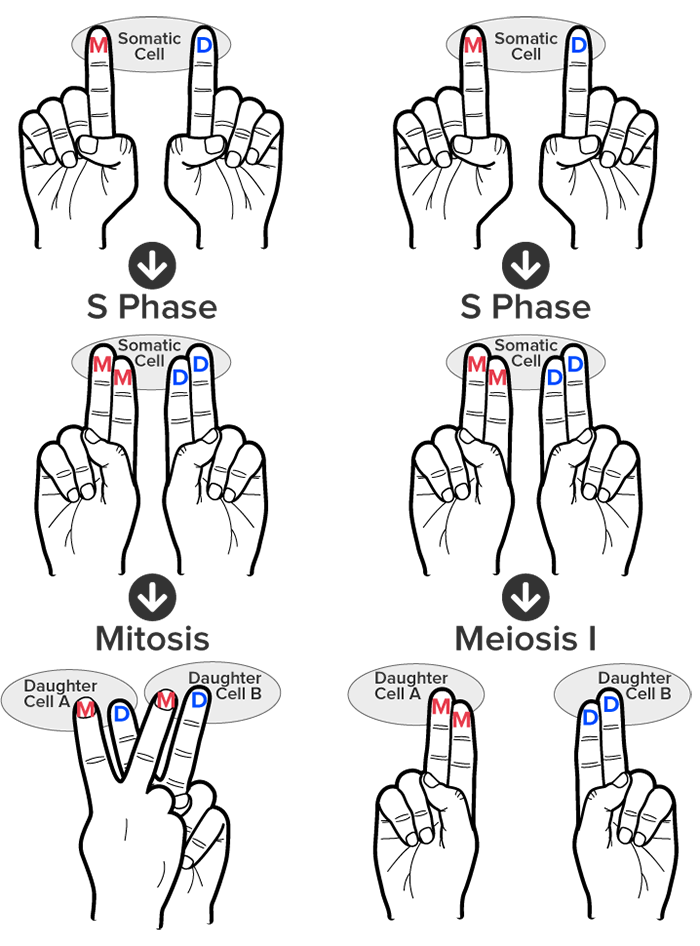In this lesson, you will learn to understand the process of meiosis and how it results in genetic variability. Specifically, this lesson will cover:
1. Meiosis Overview
Meiosis is a type of cell division that is specific to germ cells, or cells that give rise to gametes. In this type of cell division, germ cells are going through a division to form gametes. Gametes are the sperm cells in men and the oocytes in women. The result of meiosis is haploid daughter cells, and haploid cells contain half as many chromosomes as the original germ cell.
-
EXAMPLE
In humans, meiosis starts out with a germ cell of 46 chromosomes and ends up with haploid daughter cells that each have 23 chromosomes.
Each round of meiosis is similar to mitosis. There are two types of meiosis, depending on if it is creating a sperm or an egg gamete:
-
Spermatogenesis is meiosis in sperm cells and leads to four sperm cells.
-
Oogenesis is the formation of egg cells and leads to one oocyte. While four cells are generated in oogenesis (just as in spermatogenesis), only one becomes an oocyte; the others disintegrate.
Whether it's spermatogenesis in men or oogenesis in women, meiosis involves two rounds of cellular division: Meiosis I and meiosis II.
-
-
- Meiosis
- A type of cell division that occurs in germ cells to produce haploid gametes.
- Germ Cell
- A cell that gives rise to gametes.
- Gamete
- A cell which contains a haploid number of chromosomes (male gametes are sperm; female gametes are oocytes).
- Haploid
- The number of chromosomes in the gametes of an organism which is equal to half of the number of chromosomes of somatic (all non-gamete) cells.
- Spermatogenesis
- The process that forms four haploid sperm cells.
- Oogenesis
- The process that forms a haploid egg cell.
2. Meiosis I
Meiosis I is the first round of meiosis. The process of meiosis is similar to mitosis. Before meiosis begins, the germ cell has undergone interphase: There was growth (G1), synthesis (S) of DNA to make two copies of every chromosome, and more growth (G2). As a result of DNA synthesis, the germ cell looks a lot like a somatic cell that's about to divide: Its 23 pairs of homologous chromosomes (46 total) now each have two sister chromatids (92 chromatids total).

-
-
- Meiosis I
- The first round of cell division in meiosis.
2a. Phases of Meiosis I
-
Prophase I: The germ cell begins in prophase I. In this phase, similar to prophase of mitosis, homologous chromosomes (each with two identical sister chromatids) will condense. Also during this stage, the nuclear envelope will break down, and spindle microtubules will attach to the centromeres.
-
Metaphase I: Chromosomes will line up in pairs of homologs (each member of a pair of homologous chromosomes is called a homolog). Remember that for each chromosome, one homolog was inherited from your mother, and one homolog was inherited from your father. Both have the same set of genes (e.g., both copies of your 11th chromosome have a gene for hemoglobin), but the homolog from your mother will have a slightly different nucleotide sequence than the homolog from your father (e.g., somewhere in the hemoglobin gene from your father's homolog is a GTG instead of a GAG). Sometimes, a gene that started on your mother's homolog will get swapped with the gene on your father's homology, creating more genetic variation between your kids and your siblings' kids, for example. This process of swapping genetic material between homologous chromosomes is called crossing over.
-
Anaphase I: This is where anaphase in meiosis looks very different from mitosis: It's in the process of disjunction, which is how the chromosomes separate. In mitosis, the sister chromatids from each homolog split and move toward opposite poles, so that each cell gets one chromatid from your maternal homolog and one chromatid from your paternal homolog (just like the original cell had). In anaphase of meiosis I, both sister chromatids of one homolog go to one pole, and both sister chromatids from the other homology go to the other pole. That means that Daughter Cell A might get Chromosome 1, 3, and 10-23 from your dad and Chromosome 2 and 5-9 from your mom. Daughter Cell B will, therefore, get the opposite: Chromosome 1, 3 and 10-23 from your mom and Chromosome 2 and 5-9 from your dad. It's completely random which parent's homolog will end up in which daughter cell. This means that the odds of you producing the exact same gamete twice are 1 in 223, or roughly 1 in 8 billion! This creates genetic diversity even among siblings.
-
Telophase I: The nuclear envelope then starts to reform, and we end up with one homolog of each chromosome instead of two, but each homolog has two sister chromatids. The cells still need to go through another round of cell division to ensure they end up with only 23 chromosomes in each cell.
-
-
- Homolog
- One of the members of a pair of homologous chromosomes; with homologous chromosomes, one homolog is inherited from your father, and one homolog is inherited from your mother.
- Crossing Over
- A process in which homologous chromosomes will exchange genetic material with one another, resulting in genetic variation.
- Disjunction
- The process of separating chromosomes; it occurs in meiosis I when homologous chromosomes are separated, and in meiosis II when sister chromatids are separated.
2b. Difference Between Mitosis
You can illustrate the difference between mitosis and meiosis I on your fingers. Hold up your index finger on each hand, and pretend that your index fingers are homologous chromosomes. Your right finger is the homolog you inherited from your mom, and your left finger is the homolog you inherited from your dad. Now, pretend your chromosomes are undergoing S-phase, so they both get synthesized. To represent this, both hands should now be holding up your index and middle finger on each hand, close together. This represents both homologs having two sister chromatids.

In mitosis, one sister chromatid from each of your parents would go into each new daughter cell (just like the original). You can represent this by facing your palms toward each other, having both hands form "peace" signs. Thus, your index fingers are going in one direction (the right index finger is the homolog from mom, and the left index finger is the homolog from dad), into Daughter Cell A. Similarly, your middle fingers split off in the same direction (the right finger from mom, the left finger from dad), into Daughter Cell B.
Here's how meiosis I is different: Start at S-phase, with two "sister chromatids" on each hand. The pair of sister chromatids from mom will head over to Daughter Cell A, while dad's pair of sister chromatids head over to Daughter Cell B.
3. Meiosis II
After telophase I is done, the cells begin meiosis II.

-
Prophase II: Spindle microtubules will attach to the sister chromatids, and the nuclear envelope will start to break down.
-
Metaphase II: In metaphase II, the chromosomes well then again line up at the middle of the cell.
-
Anaphase II: Anaphase II looks like mitosis: Sister chromatids separate, and start moving towards opposite poles.
-
Telophase II: Again, in telophase II the nuclear envelope will reform. This time, the end will result in four haploid nuclei, all that have 23 chromosomes. The reason sex cells are haploid is that when the sperm fertilizes the oocyte, the nuclei combine with to form a diploid cell.
-
EXAMPLE
In humans, both the sperm cell and the egg contain 23 chromosomes which combine to give a total of 46. In you, half of these came from your mother and half from your father.
-
-
- Meiosis II
- The second round of cell division in meiosis.
- Diploid
- Cells that contains two sets of each chromosome.
-
If you're taking the Human Biology Lab course simultaneously with this lecture, it's a good time to try the Exploring Human Reproductive Cells Activity in Unit 7 of the Lab course. Good luck!
Meiosis is the process of cell division that creates gametes. There are two phases of meiosis. In meiosis I the cell goes through prophase I, like in mitosis, homologous chromosomes will condense and pair up. Unlike mitosis, they will also swap segments of themselves to create genetic variability. The cell will move through metaphase I and anaphase I, ending in telophase I with two haploid cells. Meiosis II is similar, but result in four haploid cells.
Keep up the learning and have a great day!


